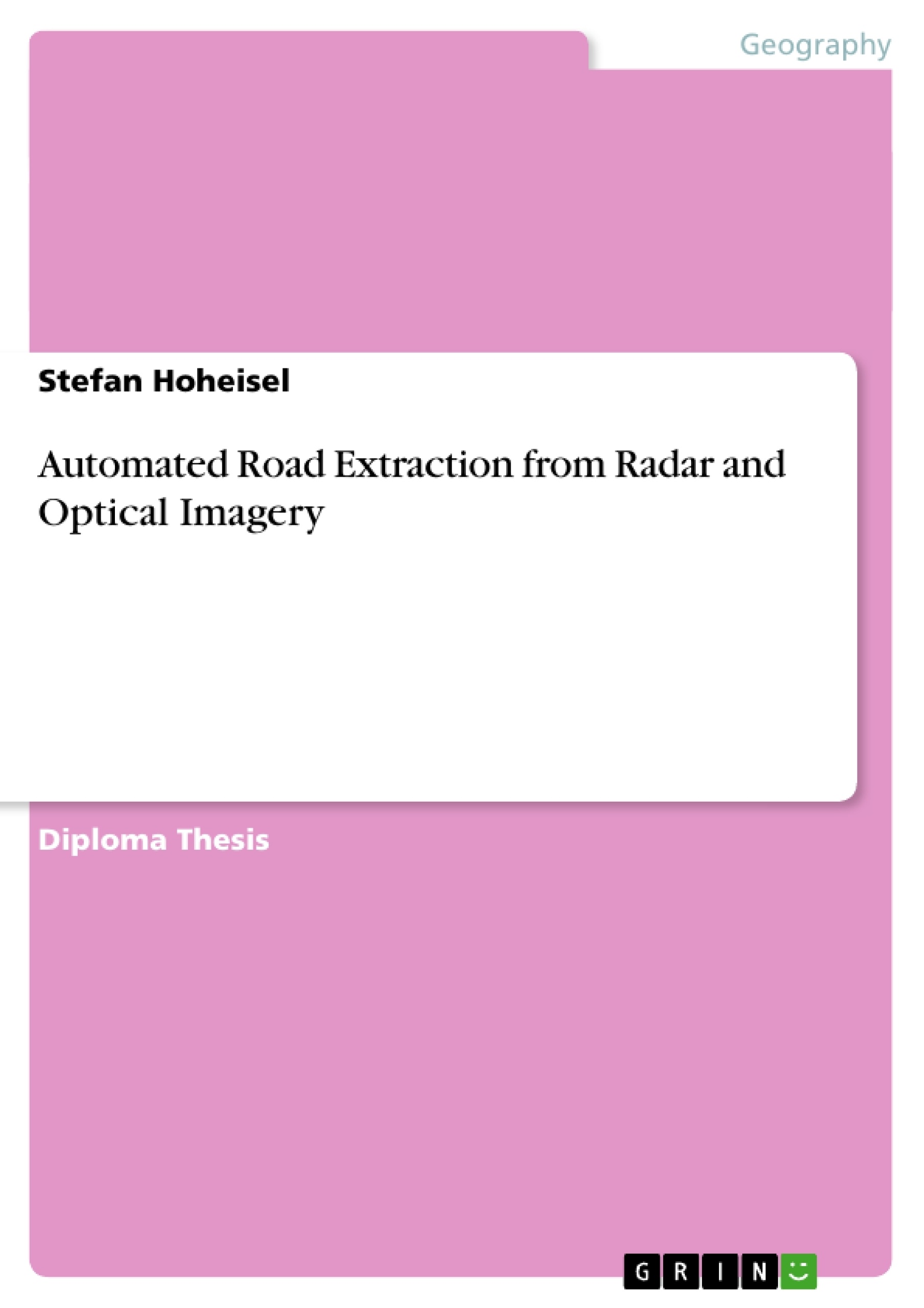The goal of this thesis is to show and compare possibilities of automated road
extraction from different imagery sources. The advantages and disadvantages of two selected extraction algorithms are explained and evaluated in detail by applying them to digital aerial photographs on one hand, and imagery stemming from airborne synthetic aperture radar on the other.
The main topic of the present work is the control of road extraction algorithms by adapting their alterable parameters to the given imagery sources, which are black and white orthophotos and radar imagery. Of special importance is the investigation of possible adaptations to regions that bear different general appearances.
The thesis also provides detailed insight into these two extraction algorithms in order to be able to optimize their application to both data sources. Furthermore, a combination of optical and radar imagery with the objective of achieving enhanced extraction results is researched. Extensive investigations and convincing examples will show the potential of automated road extraction, taking into account the arising opportunities as well as present limitations.
Inhaltsverzeichnis (Table of Contents)
- Introduction
- Motivation
- Goal and contents
- Radar systems
- Basic principles of radar systems
- Airborne and spaceborne radar systems
- Radar image properties
- Differences between radar and optical imagery
- Areas of application for radar images
- Extraction of linear objects from SAR and optical imagery
- Road models for SAR and optical imagery
- Road models for optical imagery
- Road models for SAR imagery
- Overview of extraction algorithms for linear features
- Unsupervised extraction for main road axes
- TU Munich road extraction
- Intermap road extraction
- Road extraction from interferometric SAR data
- Selection of algorithms for further examination
- Road models for SAR and optical imagery
- Extraction algorithms
- Acquisition of global context
- Intermap extraction algorithm
- General approach
- Consideration of global context
- Adaptations for use with optical imagery
- TU Munich extraction algorithm
- General approach
- Consideration of global context
- Adaptations for use with SAR imagery
- Practical analysis of extraction algorithms on SAR imagery
- Intermap extraction algorithm on SAR imagery
- Test approach
- Results and evaluation
- Results for urban areas
- Results for open areas
- Intermap extraction algorithm on SAR imagery
Zielsetzung und Themenschwerpunkte (Objectives and Key Themes)
The diploma thesis focuses on the automated extraction of roads from radar and optical imagery, aiming to develop and assess algorithms for this task. The work explores the use of various techniques and methodologies, comparing their performance and effectiveness in identifying road networks from different image sources.
- Automated Road Extraction from Different Image Sources
- Comparison of Algorithms for Road Detection in Radar and Optical Imagery
- Analysis of Road Models and their Applicability to Different Image Types
- Integration of Global Context into Extraction Algorithms
- Practical Evaluation of Algorithms on Real-World SAR Data
Zusammenfassung der Kapitel (Chapter Summaries)
- Introduction: The chapter introduces the motivation for the thesis, outlining the importance of road extraction and its applications in various fields. It also defines the specific goal and scope of the research, emphasizing the focus on automated methods and the analysis of different image types.
- Radar systems: This chapter provides a comprehensive overview of radar technology, focusing on its principles, different types of radar systems (airborne and spaceborne), and the characteristics of radar images. It also discusses the differences between radar and optical imagery, highlighting the unique properties and challenges associated with each.
- Extraction of linear objects from SAR and optical imagery: This chapter delves into the methods and models used for extracting linear features, specifically roads, from both SAR and optical imagery. It explores different road models and discusses the limitations and strengths of various extraction algorithms. The chapter also outlines the selection criteria for further examination of the algorithms chosen for the research.
- Extraction algorithms: The chapter provides a detailed description of the chosen extraction algorithms: the Intermap and TU Munich algorithms. It explains the general approach, the consideration of global context, and the adaptations required for use with both SAR and optical imagery. This chapter lays the groundwork for the practical analysis and evaluation of the algorithms.
- Practical analysis of extraction algorithms on SAR imagery: This chapter presents the results of the practical analysis conducted on SAR imagery using the Intermap extraction algorithm. The chapter details the test approach, the evaluation methodology, and the results obtained for both urban and open areas.
Schlüsselwörter (Keywords)
The main keywords and focus topics of the text include automated road extraction, radar imagery, SAR data, optical imagery, linear feature extraction, road models, algorithm comparison, global context integration, and practical analysis.
- Citar trabajo
- Stefan Hoheisel (Autor), 2003, Automated Road Extraction from Radar and Optical Imagery, Múnich, GRIN Verlag, https://www.grin.com/document/29430




